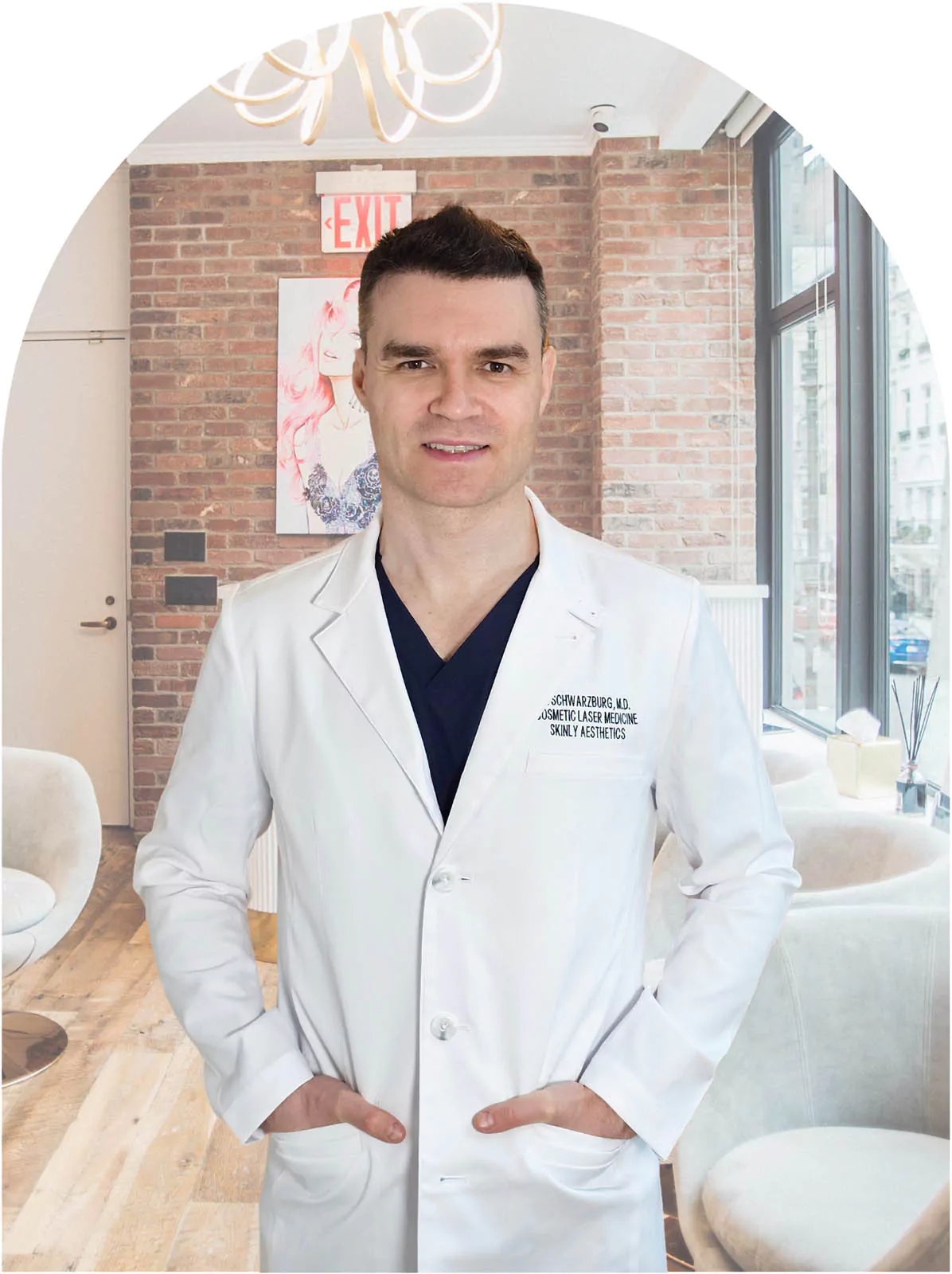WHAT IS ULTHERAPY?
Certain beauty trends come and go, but a fresh face is timeless. Unfortunately, human beings weren’t built to stay 21 forever, and skin laxity is an issue many of us deal with as we go up in age. This stems largely from reduced collagen and elastin production as we get older; as cellular fibroblasts in our bodies age and mature tissues experience defective mechanical stimulation, collagen synthesis decreases. Collagen serves as a structural and strengthening component in the skin. This loss of collagen, coupled with the breaking down of the body’s elastic fiber network and decreased hydration at higher ages, leads to atrophy of the dermis and facial ligaments.
Book NowABOUT ULTHERAPY
After the age of 20, collagen production in the body actually decreases by 1% every year. From fine lines and wrinkles to an overall drooped appearance, nobody wants to deal with the aesthetic effects of aging or sagging skin. That’s why so many of us turn to invasive face lifts or fill heaps of shopping bags filled with expensive products, wasting an overwhelming amount of time, money, and effort into trying to maintain a radiant, youthful face. And while we all wish that photo filters can be applied to real life, they don’t do much outside of social media. In New York the obsession with how one looks is real – there’s a lot of competition both on the personal and professional fronts and to be successful one has to look the part. Ang given that in NYC nobody can afford to take their finger off the pulse of the city – it only comes as an advantage that Ultherapy carries no recovery period of any kind, allowing you to get back to your life immediately. Luckily, there is a safe, effective alternative solution to achieving a firm and lifted skin: Ultherapy.
Ultherapy is a FDA-approved, non-invasive cosmetic treatment that works on several levels to create more youthful looking skin via focused ultrasound therapy. Microfocused ultrasound energy (also referred to as MFU) is administered via transducers that emit varying frequencies based on the specific targeted region. This energy penetrates certain layers of skin tissue – namely the SMAS, or superficial muscular aponeurotic layer of the skin to produce controlled micro-damage; this thermal effect, which occurs at temperatures over 60°C, in turn, jumpstarts the production of de novo collagen and elastin in the body. Because these energy beams penetrate with laser-sharp precision to the subcutaneous region of the skin, the more superficial papillary dermal and epidermal skin layers are safe from damage. At the same time, your doctor is able to visualize the energy beams in the tissue planes and facial anatomy through high-resolution ultrasound imaging, pinpointing the right focal depth.
With few side effects and no downtime, this process focuses on the facial superficial musculoponeurotic system to gradually plump and lift the skin throughout the following months. It can be used to target multiple areas of the face, including the eyebrows, chin, jawline, decolletage, and neck.
WHY DO PEOPLE LOVE ULTHERAPY?
More and more, we’re used to seeing celebrities and influencers sport smooth skin that seems completely resistant to the turning wheels of time. Some of it can be explained away by genetics, and there’s not much you can do about that. But don’t worry, it’s not all predetermined – there are actually tons of medical cosmetic treatments on the market that target the signs of aging or exhausted-looking skin. From fillers to Botox injections to facelifts, you’ve probably heard of many of them – but Ultherapy might be a completely new term for you. Despite being offered in over 75 countries and performed more than 1.5 million times, many of us still are not familiar with Ultherapy as a cosmetic procedure. For those who do not want to undergo the risks of surgery and aren’t seeing results using topical products, Ultherapy is a wonderful solution proven to work through multiple clinical studies.
Dr. Schwarzburg, who practices cosmetic dermatology in New York, notes that Ultherapy, which is an advanced form of ultrasound skin therapy has grown in popularity for being a non-invasive choice for those who desire something akin to a facelift. That means facial creases, lines and lax skin, as well as other signs of maturing skin, can be treated using Ultherapy without any of surgical downtime and potentially serious complications. Particularly in patients who only need mild adjustments, this can be a real lifesaver. Not everybody wants to go for the drastic measures of surgical intervention to correct a couple of fine lines or the early marks of sagging skin in the face and neck. There are plenty of ways to add buoyancy to the skin using non-invasive solutions, and Ultherapy is one of them.
WHAT IS THE SCIENCE BEHIND ULTHERAPY?
The SMAS is a fibrous network that connects the facial muscles to the dermis. SMAS also connects to various facial retaining ligaments that together with levator muscles of the face keep the skin tight and taut. Dr Schwazburg, a leading cosmetic surgeon in NYC, explains that weakening of zygomatic and upper masseteric ligaments is what leads to “sliding of the face” downward with tissue sagging along the zygomatic and mandibular vectors. In the past these processes was essentially irreversible requiring invasive plastic surgery when patients would reach their late 50s or 60s. However with advent of focused ultrasound therapy like Ultherapy or deep fractional microneedling like Secret RF, it has become possible to both prevent and reverse effects of gravity and advanced age. The energy that is generated during
Ultherapy procedure is both very powerful and uniquely focused with real-time ultrasound visualization ensuring the accuracy of the applied energy beams. This allows doctors to reach ultimate precision in treating small and delicate anatomic parts of the face. The body’s regenerative response brings about neocollagenesis in the treated area; over time, the development of new viscoelastic collagen firms and lifts loose skin in this area by strengthening and reinforcing both SMAS and retaining facial ligaments.
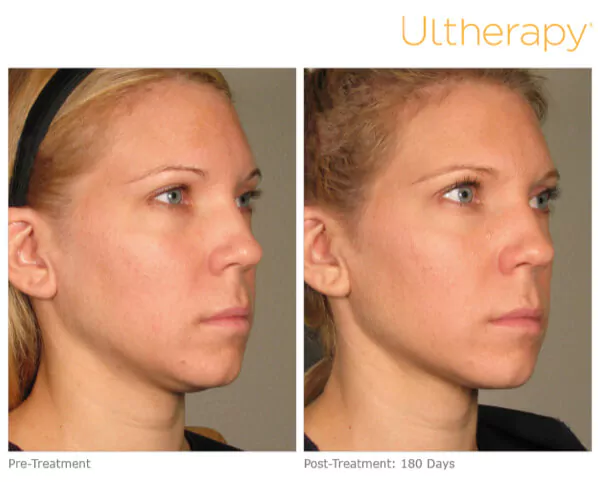
HOW CAN ULTHERAPY TREAT DIFFERENT AREAS OF THE BODY?
The ultrasound beams used in Ultherapy can be administered at different energy levels, wavelength configurations, and focal depths depending on the body part and patient being treated. By encouraging the body’s natural healing process, Ultherapy can rejuvenate areas on and surrounding the face, and occasionally the thighs. Here are some regions of the body that Ultherapy is commonly used on:
Ultherapy for the jawline: A lot of us yearn for a more contoured and snatched jawline. The jawline and chin can begin to look weaker as we get older, a frustrating side effect of aging as we all hope for a delicate, defined profile. Ultherapy can help sculpt and lift this area. The shape of the jawline can become obscured with flabby skin and Ultherapy tightens skin to reveal bone structure and also give the area a smoother, younger appearance.
Ultherapy for the neck: The neck is one of the first areas of the body that shows signs of aging. Looking up, down, and side to side every day means that the neck sees a lot of stretching action. This stretching, along with the fact that many of us forget to moisturize and protect the skin on our necks, often leads to it maturing faster than the rest of our bodies. With the loss of flexibility-supporting elastin and collagen over the years, issues like the dreaded turkey neck, double chins, and folds and wrinkles on the neck get worse. Thankfully, the firming power of Ultherapy can smooth these out by aiding in collagen and elastin synthesis and restoring skin elasticity.
Ultherapy for stretch marks: Stretch marks, aka tiger stripes or striae, appear as horizontal dents and rivets in the skin. These striae, often occurring due to thinned or stretched skin, are extremely common; up to 86% of post-pubescent women have at least some stretch marks. Still, most of us are bothered by their appearance and try to disguise them with ineffective lotions and creams. By stimulating the production of collagen, Ultherapy can help fill these divots and reduce the appearance of stretch marks aka tiger stripes. It can also prevent stretch marks from occuring by increasing the collagen and elastin that lend the skin flexibility and buoyancy.
Ultherapy for the mouth: One of the major areas of concern people have when it comes to premature aging is the mouth, since our muscles there tend to see so much action. Smile lines, marionette lines, and nasolabial folds can become more pronounced as we get older and visually draw the face downwards; Ultherapy can correct these minor wrinkles. By hitting the subcutaneous layer with ultrasound energy, Ultherapy triggers our body’s healing response which, in turn, encourages skin rejuvenation.
Ultherapy for the eyes: As you get older, crow’s feet or wrinkles below the eye sockets can become more pronounced. A lot of people try to cover these up with concealer, only to find that a lot of make-up actually sits and pills on the skin, balancing the complexion but not the texture of the skin. Ultherapy can treat these things early on for a more youthful glow, evening out crepey undereyes.
Ultherapy for the forehead: Especially for those of us who are extra expressive, forehead wrinkles are a frequent occurrence. You may take extra notice of them when you see deep lines etched in your forehead in photos, even when your eyebrows aren’t raised. A lot of people turn to Botox to treat wrinkles on the forehead –– through muscular relaxation –– but Ultherapy can actually trigger the production of collagen in this area, making the forehead look smoother and brightening up your expression.
Ultherapy jowls: Jowls are the pockets of excess fat or sagging skin beneath the jawline. A well-defined jawline is one of the forefront factors of a flattering profile; jowls can often get in the way of our confidence, especially when maintaining a neutral expression. Fortunately, this region can be lifted and tightened using Ultherapy.
Ultherapy brow lift: Similarly to the chin and jawline region, the brows can often appear to sag as you get older. With the downward decline of the brow often comes a sad, exhausted, or jaded-looking appearance. It also draws the entire eye area down –– and who wants to drag down the focus of the face? Ultherapy helps skin bounce back, lifting the brow area for a face that looks alert, happy, and healthy.
Ultherapy for the chest: While people don’t pay as much attention to this area, the decolletage is often the site of many fine lines and wrinkles. This is particularly true if it has been exposed to a lot of sun over the years, as many of us forget to wear sunscreen on the chest every day. Chest wrinkles can be targeted with Ultherapy, as ultrasound energy beams jumpstart the body’s regenerative response for increased collagen synthesis.
Ultherapy for the thighs: Sagging skin, wrinkles, and stretch marks tend to befall the thighs in men and women alike. When sporting shorts, mini-skirts, or bathing suits, most of us would rather show off smooth, healthy thighs. While Ultherapy is more commonly used above the chest, it can be a viable treatment for leveling out skin texture on the thighs as well.
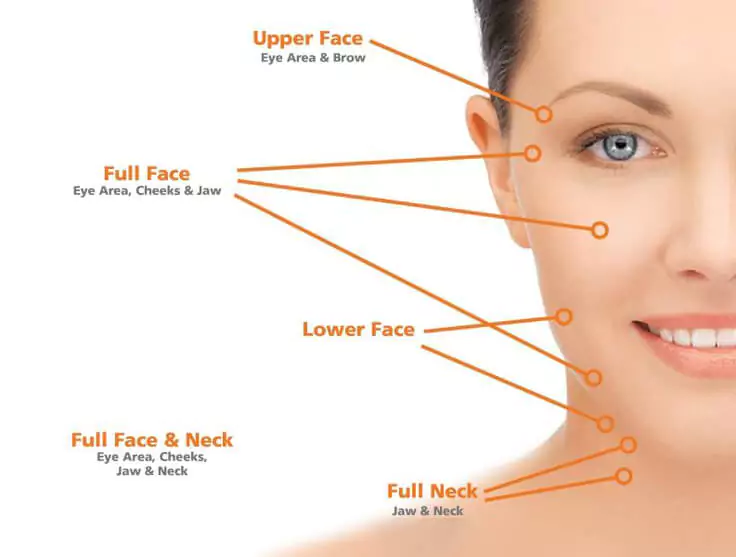
WHO IS AN IDEAL CANDIDATE FOR ULTHERAPY?
You may be reading all about Ultherapy and wondering if it’s the right treatment for you. After all, there are a lot of different cosmetic options out there, both invasive and non-invasive. In general, Ultherapy is recommended for patients who are 30 years or older and are bothered by those pesky early signs of aging –– such as drooping skin, fine lines, and overall sagging and heaviness in the face. If you are otherwise healthy and looking for mild, but noticeable improvements in your skin, Ultherapy might be a fantastic choice for you.
If you want to treat more severe signs of aging with excess skin, have active acne or skin infections, or recent filler in the targeted region, you may not be the ideal candidate for Ultherapy. If you live in New York it best to talk to Dr. Schwarzburg to make sure that you can reap all the benefits out of Ultherapy that you desire, and that you have no contraindications or health conditions that may bar you from the procedure.
If you’re wondering what makes you ineligible for Ultherapy, it’s best to discuss this during your consultation. Contraindications include severe cystic acne, as well as other skin conditions or extreme sun damage in the targeted area. If you have any active or metallic implants, such as a pacemaker, you might also not be able to get Ultherapy. Wounds, lesions, or infections in the treatment area will also prohibit you from having this procedure. If you are pregnant or a minor, you cannot get Ultherapy.
WHAT TO EXPECT FROM YOUR ULTHERAPY APPOINTMENT?
If you’ve decided to take the leap into your beauty journey with Ultherapy, Skinly Aesthetics in NYC is a great place to do so. Before the procedure, Dr. Schwarzburg will sit down and talk to you about your aesthetic vision, your health and medical background, and any questions or worries you might have. This consultation is important to make sure that you and Dr. Schwarzburg are on the same page about your treatment, and to establish realistic goals and eligibility.
After your consultation, you may schedule your Ultherapy appointment, or you might be ready to head straight into it. There is no pre-procedure prep required; just make sure to plan for about 30 to 120 minutes of treatment time.
Before treatment, the targeted area will be cleaned and covered with an ultrasound gel. Dr. Schwarzburg will use a handheld Ultherapy applicator to treat the region of concern while employing advanced ultrasound imaging as a visualization tool for maximum precision. You may feel some burning or stinging during the treatment, which can be eased by lidocaine or NSAIDs. At the end of your treatment, you can jump back into your regular everyday activities.
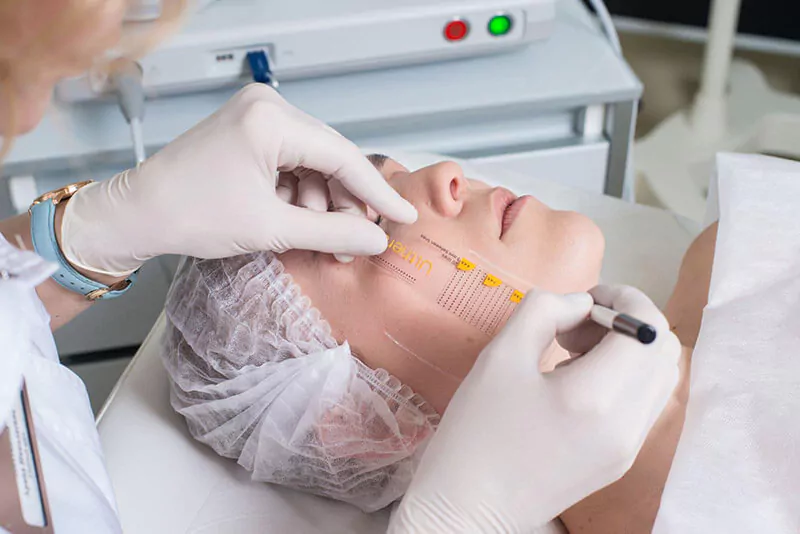
HOW LONG DOES IT TAKE TO GET ULTHERAPY?
We all lead busy lives, especially those of us who live in New York. Most of us don’t have time to spare for a lengthy or complicated cosmetic procedure. Fortunately, Ultherapy is easy to fit into your packed schedule, especially because it doesn’t require any downtime. While every patient is different, you should set aside 30 minutes to 2 hours for an Ultherapy procedure.
If you want to get a more clear picture on the length of your procedure, be sure to ask your provider in advance for exactly what to expect. A larger treatment area –– like the chest –– is likely to guarantee more time in the clinic. If your skin laxity is more severe or you have a larger amount of wrinkles or thinness to address, your session will probably be on the longer side. Pain tolerance can also play a factor; you may need time for numbing agents or pain relievers to kick in before the procedure begins. Finally, it’s always possible that a single session isn’t enough to get you the results you want. That’s because everybody has a different response to the thermal damage done by the ultrasound beams – a weaker response may justify several sessions in order for significant change to be achieved.
WHAT ARE THE COMMON ADVERSE EFFECTS OF ULTHERAPY?
Many people flock to Ultherapy as a de-aging method due to its low-risk, high-reward nature. Side effects with Ultherapy are minimal, with the most frequently occurring side effect associated with Ultherapy is discomfort or pain during the procedure. This can be minimized using topical lidocaine or NSAIDs. Temporary swelling (edema), bruising, or redness (erythema) are also expected to occur, but are usually very mild in nature lasting only a few days.
Ultherapy is a very potent device that is capable of both bringing back the beauty, but also wrecking havoc if inappropriately used. The most dreaded side effect is temporary or permanent nerve damage which happens when marginal mandibular nerve or temporal branches of the facial nerve get zapped with too much energy. This subsequent muscle weakness in the lower face results in asymmetric and crooked smile and the inability to properly drink and eat. Most of the time the effects are transient, but can be permanent if too much thermal energy is used inadvertently. Other serious side effects include post-inflammatory hyperpigmentation, numbness, and the appearance of linear skin patterns or scarring. All of the above mentioned complications can have a devastating effect on your social and work life. An experienced provider who practices proper technique, like Dr. Schwarzburg in NYC, can help avoid such adverse effects with Ultherapy.
WHAT IS THE RECOVERY TIME FOR ULTHERAPY?
There is no recovery period to worry about when getting Ultherapy. While surgical face lifts can come with a lot of post-procedure restrictions and aesthetic downtimes, Ultherapy allows you to resume your life immediately after the procedure. You may want to stay out of the limelight for a day, because it’s common to experience edema or erythema (skin appearing swollen or red) after Ultherapy; this is due to the deep layers of your skin being hit with ultrasound energy and it reacting to mild trauma from the treatment. These effects should abate within a few hours, however.
The best thing to do after your Ultherapy treatment is to simply be gentle with your skin. As always, you should wear sunscreen and use gentle cleansers and moisturizers that won’t irritate your skin.
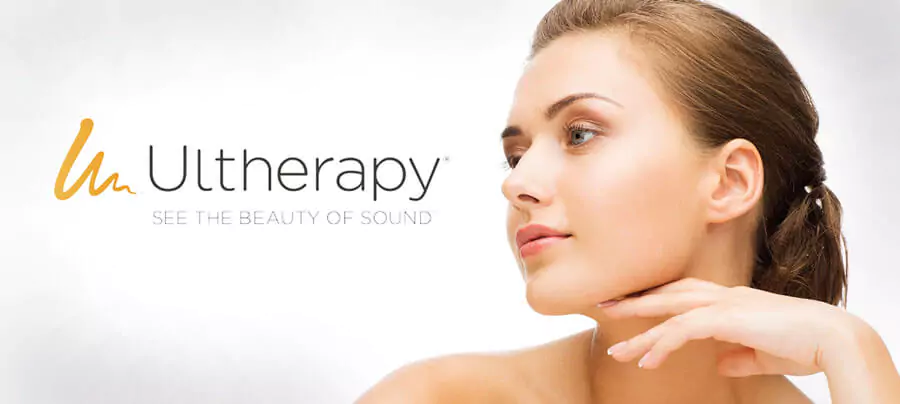
HOW EXPENSIVE IS ULTHERAPY?
When it comes to smooth, youthful skin, most of us are willing to shell out a lot of money to maintain our physical appearance. Ultherapy is often a better investment than subscriptions to more ineffective beauty products and creams. The exact price can vary based on the location of the clinic you visit, the treatment area, and how many sessions of Ultherapy you need for your desired results. It can also depend on the expertise of your provider, which you don’t want to gamble on – for example, a highly qualified and experienced physician like Dr. Schwarzburg in NYC will be able to provide more precise Ultherapy results than somebody with less training. In general, New York City clinics with highly experienced physicians can be more expensive than those in rural areas with less qualified practitioners. If you come in with generally healthy skin and mild laxity but only a few narrow fine lines, you can also expect a speedier, cheaper treatment. Those with deeper wrinkles and more noticeable saggy skin will probably need more sessions and will thus end up spending more money. A single appointment in New York generally costs around $1000 to $4000; more severe cases may need around 5 treatments, which can add up to $20000. It can also be hugely beneficial to combine Ultherapy treatments with something else; for example, if you deal with a flabby neck and double chin, a fat-targeting treatment like Kybella or CoolSculpting can help give the treatment the extra boost to achieve the slender, sculpted look you want.
WHAT TREATMENTS ARE COMMONLY USED IN CONJUNCTION WITH ULTHERAPY?
There are a whole host of skin concerns that can be addressed with Ultherapy or similar treatments. While Ultherapy can help you get that lifted look we all crave, there are more ways to smooth and tighten lax skin. In terms of minimally-invasive treatments, you may want to look into a Forma laser, Fraxel laser treatment, or Secret RF fractional microneedling, which utilizes radiofrequency to diminish the size of pores, tighten the skin and improve sun damage. These treatments employ a similar method to Ultherapy –– controlled skin damage that encourages the production of collagen and elastin for elevated skin structure.
You can also wipe out wrinkles using neurotoxins like Botox or Dysport; these smooth out the skin by paralyzing and preventing the contraction of certain facial muscles that contribute to wrinkles in the first place. If you are dealing with excess skin and jowls in the lower face, a non-surgical PDO thread lift can be used alongside Ultherapy for the ultimate lifted effect, as Ultherapy alone cannot usually target this specific concern.
HOW MANY ULTHERAPY SESSIONS ARE NEEDED FOR BEST RESULTS?
There is no set number of necessary Ultherapy treatments, because no two patients are alike. Some patients may respond more significantly to the ultrasound laser than others. The size of the treatment area and the severity of skin laxity, coupled with how dramatic of a change you want to see, can impact how many sessions of Ultherapy you will end up getting. For example, a patient who is 60 years old and has deep nasolabial wrinkles and heavy jowls may need 3 or 4 sessions and might have to wait around 6 months post-treatment to really see improvements. This can increase to 5 or 6 sessions if their body doesn’t have a strong regenerative response, as is often the case in older folks whose healing process has slowed. A younger individual, such as someone in their early 30s, who is just starting to see shallow lines on their forehead and the beginnings of neck wrinkles may only need a session or two to get the results they crave. Dr. Schwarzburg who practices cosmetic medicine in New York notes that the majority of patients go for 2 to 3 sessions of Ultherapy for their desired outcome. You may also want to schedule touch-up sessions in the future to keep your skin looking young for longer.
DOES ULTHERAPY HURT?
While you shouldn’t expect to feel any intense pain during this treatment as it is non-invasive with only microscopic levels of damage below the surface of the skin. Most patients describe the sensation as stinging, tingling, or burning sensation. Some experience only mild discomfort, while others report quite a bit of pain in the area, as well as tenderness for a few days after treatment. Everybody has varying levels of pain tolerance; patients have reported pain during an Ultherapy procedure to be anywhere from 3 to 7 on a scale of 1-10. If you’re worried about the procedure being painful, you can request a local anesthetic, pain meds, or a sedative to numb the area and relieve irritation.
HOW LONG BEFORE I SEE ULTHERAPY RESULTS?
The outcome of Ultherapy is not instantaneous. It relies upon the body’s natural healing response and production of collagen that is triggered by focused thermal injury – this means that it can take upwards of three months to see the final results. Some patients will notice changes quicker than others, as the body’s regenerative response differs from one individual to the next. Studies have proven that, while some changes are already evident 2 months after treatment, 93% of patients see improvements by the end of a 6 month post-treatment period. 85% of these patients felt that the results of the treatment at this time were satisfactory, and that’s after only a single session.
Some patients might also require several sessions for collagen growth to be significant enough for noticeable change; a single session can reduce light marionette lines, for example, but might not be sufficient to gloss over more wobbly neck folds. For a lot of people, the steady progression of the treatment is actually an added bonus – gradual results will appear more natural and discreet, so you don’t have to deal with intrusive questions about if you “had work done.”
GAUGING BEFORE AND AFTER RESULTS OF ULTHERAPY – WHAT TO EXPECT?
Many patients turn to Ultherapy non-surgical facelift to correct droopy eyebrows, wrinkles surrounding the eyes and mouth, and sagging skin around the chin and jawline.
Hooded eyebrows and jowl sagging are the primary indicators for patients to undergo the Ultherapy treatment. While we all inevitably age, we all want this process to be graceful and reflect our inner image, as the physical appearance and our inner self-image are often misaligned. In this day and age there are multiple nonsurgical options for skin rejuvenation and Ultherapy is one of those game-changers in the field of cosmetic medicine and routinely achieves results that rival a full surgical facelift.
After your Ultherapy treatment for hooded eyebrows is complete, you will notice a subtle but flattering lifted effect in the periocular area, as well as stronger, more supple skin with both your eyebrows and your eyelids raised for a youthful and brightened look. If jowling was the main problem then over the course of 2-4 months after your treatment the overhanging skin will start to retract and lift itself and as collagen production intensifies and the SMAS layer become more contracted. The most important aspect with post Ultherapy results is patience.
How exactly this minimally invasive facelift treatment manifests and reads on your face depends on your physical makeup – some may experience greater results, while others have a more subtle response. Dr. Schwarzburg can help you get a better idea of what your before and after resutls will look like during your Ultherapy consultation at his private cosmetic surgery clinic in New York. In general, however, patients are very happy with the outcome. In the end, you will experience smoother skin that has been freed of the marks of older age. You may even notice that your face appears brighter, that your expressions are lighter and more open; this can happen in particular when the areas around the mouth and eyes are treated, eliminating droopiness and lines that can contribute to an exhausted look.
HOW LONG DO ULTHERAPY RESULTS LAST?
Ultherapy is an excellent way to successfully curb the speed at which aging occurs by visibly reducing its signs, like fine lines and wrinkles. However, that doesn’t mean that it will halt the aging process forever; you can usually see the results of Ultherapy for about 2 years, or even more, before the natural aging process resumes with gravity and other forces pulling down on your skin. You can help prevent this by regular follow-up visits with Dr. Schwarzburg in the future, or by exploring other non-invasive treatment options, like Secret RF skin tightening or Fraxel laser treatments.
IS ULTHERAPY REALLY WORTH IT?
Opting for Ultherapy is worth it if you’re looking to tighten, lift, and plump the skin, particularly in the lower third of your face including the submental area. When it comes to the efficacy of this treatment, countless reviews, personal testimonials, and academic studies have proven the success of nonsurgical facelift that can be achieved with Ultherapy. In a certain study, the rate of collagen synthesis has been shown to increase by 42% on skin treated with Ultherapy; collagen is the protein that gives the skin strength and elasticity, meaning that higher collagen production does indeed reverse the signs of aging. Another study depicts an definitive neck and jowl lift in 72.9% of patients who had undergone Ultherapy on their necks. A different clinical trial showed that at 180 days following Ultherapy procedure, 77.8% of patients noticed improvements in skin laxity; these improvements tend to be higher after multiple sessions, which might be beneficial if your skin concerns are moderate rather than mild. The results speak for themselves: people are overall very satisfied with the effects of Ultherapy when it comes to improved skin tightness and plumpness.
WHAT IS THE DIFFERENCE BETWEEN ULTHERAPY AND OTHER LASER SKIN TIGHTENING METHODS?
The main difference between Ultherapy and other laser skin tightening treatments is Ultherapy’s ability to penetrate and render its effects in deeper layers of the skin. This is possible because Ultherapy uses sound energy, as opposed to light energy, which can only affect more superficial dermal layers. This unique characteristic allows Ultherapy to promote collagen growth in the deep SMAS layer, and to shrink and lift the skin to get the results of a non-surgical facelift . Other laser treatments often simply remove the top layer of skin, focusing on skin resurfacing to combat aging and scarring. RF (radiofrequency) and Fraxel laser treatments use thermal energy and electromagnetic waves to achieve similar skin rejuvenating effects as Ultherapy. These often treat more superficial layers of skin, while Ultherapy can penetrate deeper and often leads to greater results in that way. Ultherapy and RF treatments are comparable in that they have little to no downtime; in fact, RF is a treatment that is generally repeated at weekly intervals. Laser therapies, on the other hand, usually need to spaced out to allow sufficient healing to happen.
ULTHERAPY VS PDO THREAD LIFT
PDO thread lifts are a minimally invasive facial contouring alternative to getting the snatched look of a surgical face lift. In a PDO thread lift treatment, small, dissolvable barbed threads are placed into the sides of the face, physically lifting up lax skin. While this provides instant results, the outcome also continues to develop over the following months as traces of collagen are left behind.
Ultherapy is often compared to PDO threads as a cosmetic skin tightening method that can leave the face looking more upturned and lifted. While they can achieve some similar effects, there are notably differences between these two treatments. While both boost collagen in the skin, it takes longer to see the results of Ultherapy. Obviously, PDO threads are also somewhat invasive, where Ultherapy is not. It’s important to discuss your options with Dr. Schwarzburg to see what you can get from either treatment.
HOW DOES ULTHERAPY PROMOTE COLLAGEN PRODUCTION IN THE BODY?
Ultherapy contributes to neocollagenesis in the body – but what does that actually mean, and how is it possible? When microfused ultrasound energy is directed to the subcutaneous layer via an Ultherapy device, it results in controlled thermal damage and tissue coagulation in the targeted points. By applying temperatures above 65°C, the ultrasound energy beams cause the hydrogen bonds holding together collagen molecules in these points of the dermis to break. The result of this is the contraction and denaturation of collagen fibers; shorter, thicker de novo collagen fibers form instead in the regions of thermal tissue coagulation within the facial planes (including the superficial musculoaponeurotic system and platysma). The creation of fresh, viscoelastic collagen gives loose areas of the dermis a lift and strengthening boost. Overall, skin around the SMAS (which connects the facial muscles and the skin) is thickened and smoothed out. This directly combats the breakdown of collagen associated with aging and droopy skin and wrinkles. It’s also why younger patients are often better candidates for Ultherapy non-surgical facelift because their body’s natural healing response is more efficient – and this healing response is what gives Ultherapy the ability to trigger a collagen-producing reaction in the first place, as the body scrambles to gloss over damage done.
DOES ULTHERAPY TREAT SAGGING NECK SKIN?
Many of us only learn later in life that a major site of premature aging is the neck. We tend to feel bothered by turkey neck –– the folds and wrinkles that form beneath the chin as we get older, exposing thin and sagging skin. Fortunately, Ultherapy can be an early line of defense against turkey neck by boosting collagen and tightening skin in this area.
HOW DOES ULTHERAPY COMPARE TO A FACELIFT?
If you have sagging skin, wrinkles, or are otherwise dealing with droopiness or signs of aging in the face, you may have considered getting a surgical facelift before. Ultherapy can provide a safer, more convenient alternative to a classical invasive facelift in a lot of scenarios. The major difference between these two procedures is that an old-fashioned facelift is an invasive, surgical procedure; Ultherapy, on the other hand, is completely non-surgical with results rivaling those of plastic surgery, and can often give you the results you’re searching for without all the risks associated with the surgery.
If you’re looking to correct mild to moderate wrinkles or achieve a brighter, plumper, more youthful look in your face, you can find great success by simply using Ultherapy. There are no incisions, needles, or surgical tactics of any kind necessary for Ultherapy, as the device is completely non-invasive and works by stimulating collagen production via ultrasound energy. A surgical facelift generally involves incisions and stitches at the side of the face; some require fat removal, injections, or facial implants, and there’s always cutting the skin and scarring. All of this requires anesthesia before the procedure and is coupled with pain and complicated side effects – such as a botched job and high risk of infection – afterwards. Even without the side effects, those who undergo a surgical face lift are burdened with a lengthy period of downtime in which they often have to take time off work and social activities. In light of all this, an Ultherapy treatment can target pesky wrinkles and skin laxity without all the risky and bothersome factors that come with surgery.
Dr. Schwarzburg, a cosmetic physician based in NYC, reminds that it’s important to remember that not everybody who wants the effects of a facelift can find a perfect alternative in Ultherapy. While Ultherapy is effective in tightening and lifting skin in the lower face region, the upper half of the face and midface area is not always ideal for this treatment. Furthermore, Ultherapy works best on mild to moderate cases; those with more advanced signs of aging, who wish to see more dramatic changes, will likely not find the kind of significant transformation that a facelift offers. Ultherapy can add strength and elasticity to the skin, making it appear smoother and younger, but it won’t change the contours of your face significantly.
WHAT IS THE SAFETY LEVEL OF ULTHERAPY?
Being non-invasive, Ultherapy is generally considered a safe and low-risk form of skin tightening. Studies have shown that the majority of side effects are consistent, well-tolerated, and temporary. This treatment has been approved by the FDA to treat signs of skin laxity and old age in the lower face and decolletage region.
WHAT ARE THE ADVANTAGES AND DISADVANTAGES OF ULTHERAPY?
Every cosmetic procedure has some advantages and disadvantages that can only properly be weighed by your physician and by yourself. When it comes to Ultherapy, the pros include a lack of surgical intervention, it being a completely non-invasive form of skin tightening. It is also a safe, low-risk, FDA approved alternative to more drastic methods, such as full blown surgical facelifts. Ultherapy offers subtle and yet reproducible results without needing to factor in any extra downtime.
Of course, there are a few cons to consider as well. While Ultherapy provides results that last for quite some time, it is not permanent and will not halt the aging process forever. It is also a gradual change that does not become apparent instantly, and may require a couple of appointments for your optimal outcome. It should also be noted that Ultherapy can be quite painful for some, so take your pain tolerance into consideration.
FINAL TAKEAWAY
Ultherapy is a skin tightening and lifting treatment that works through the delivery of ultrasound energy into the subcutaneous layer of the skin. Through controlled thermal damage, this process encourages the growth of collagen for dermal rejuvenation and restoration. While the treatment itself takes half an hour to two hours, the final results will become visible within a few months post-treatment – during this time, there is no pesky recovery period and a minimal risk of side effects. Ultherapy can help you achieve a more youthful, refreshed look in a non-invasive way that lasts for up to two years.
WHERE SHOULD I GET ULTHERAPY?
Ultherapy employs advanced technology that produces its best results when in the hands of a thoughtful, experienced medical professional like Dr. Schwarzburg. For many years, Dr. Schwarzburg has carried out non-invasive and minimally invasive cosmetic procedures like Ultherapy at his practice, Skinly Aesthetics, located on the Upper East Side of Manhattan. We take pride in offering you the best in cosmetic care to fully realize all your face and body goals, while minimizing associated risks. If you’re eager to try out Ultherapy for yourself, give us a call at (212) 774-4264, or send us an e-mail at info@skinlyasethetics.com.
Explore treatment options tailored just for you. Schedule your consultation right now.
Consult with Dr. Schwarzburg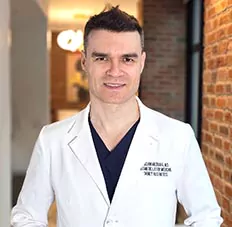
 info@skinlyaesthetics.com
info@skinlyaesthetics.com  212-774-4264
212-774-4264 


















